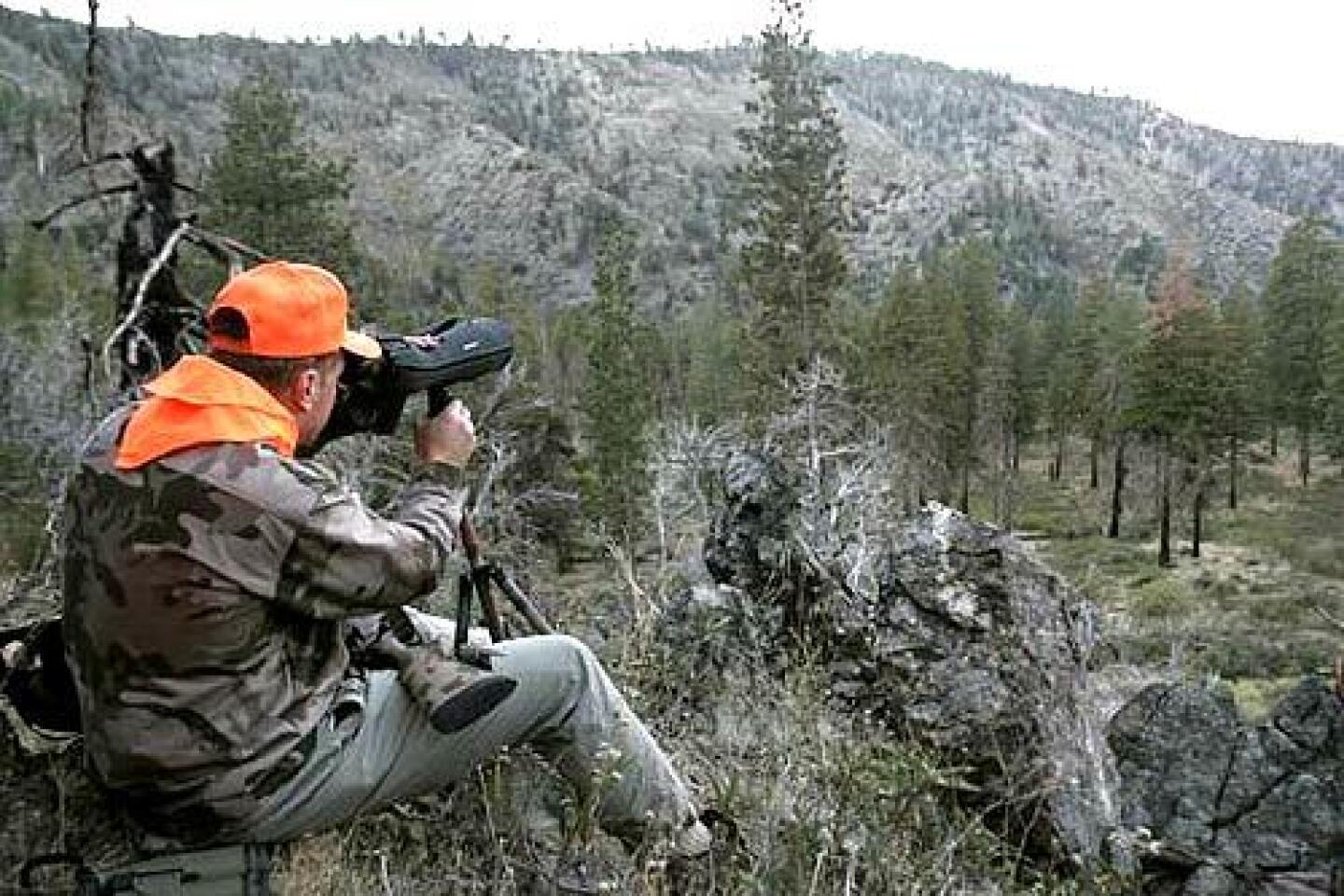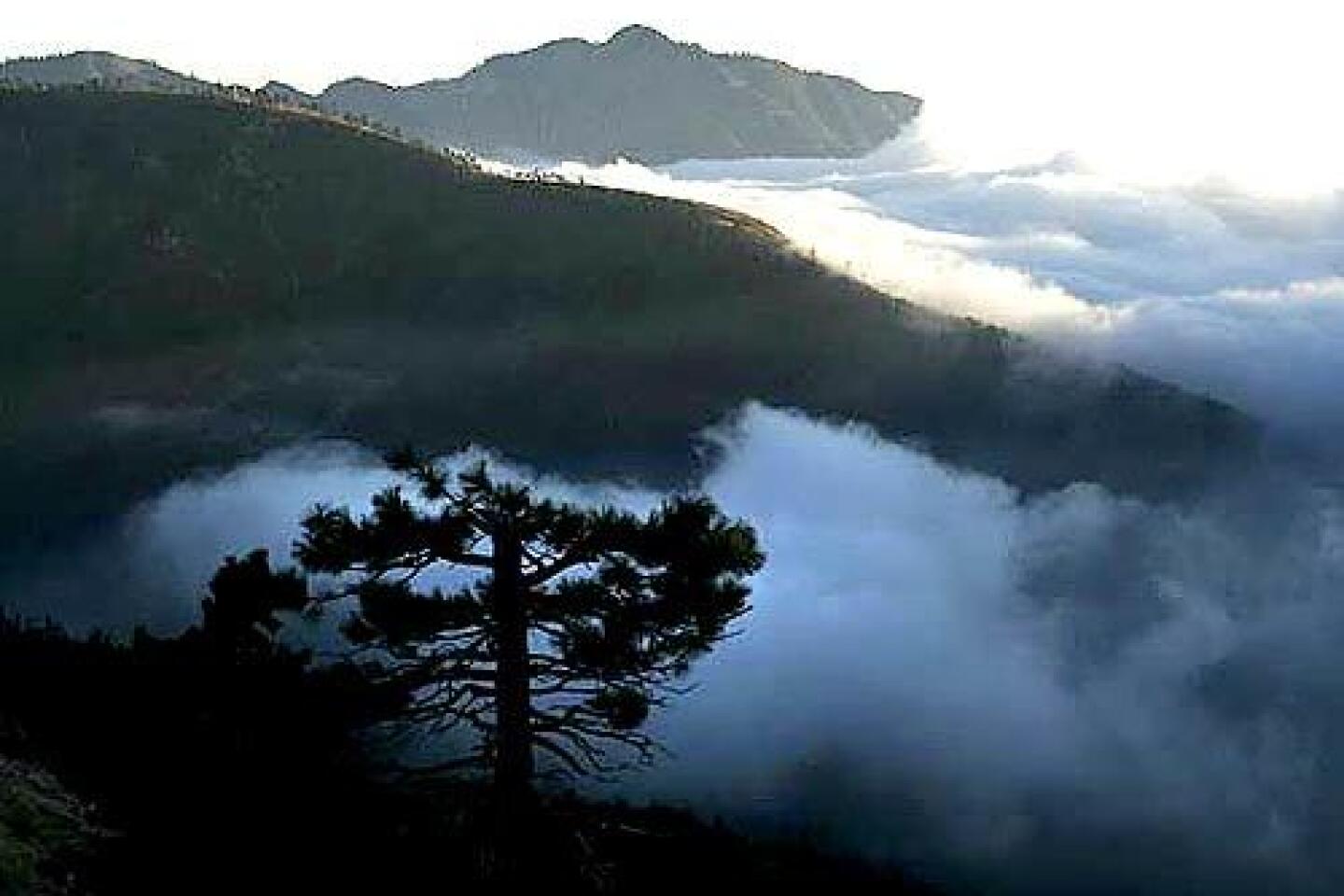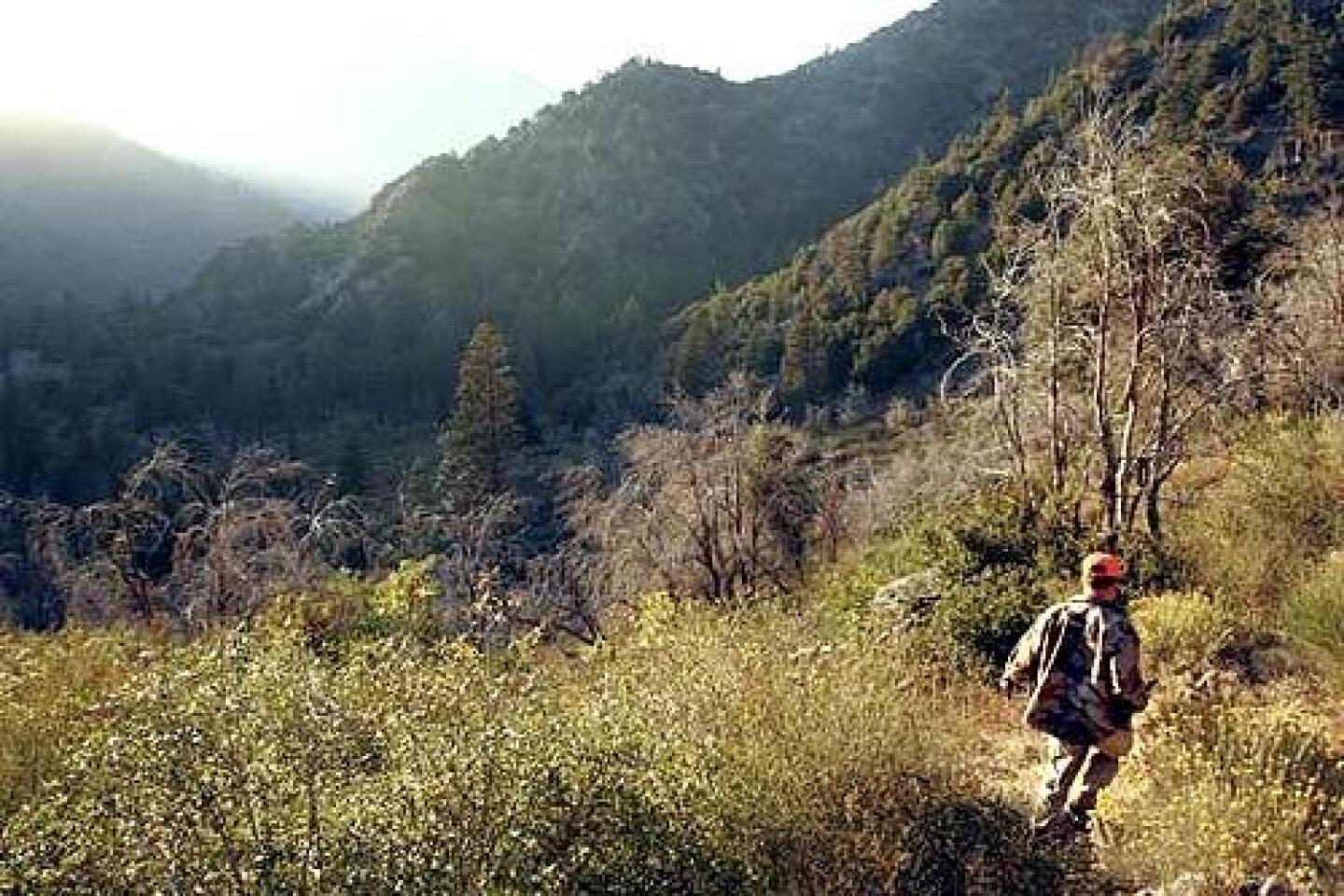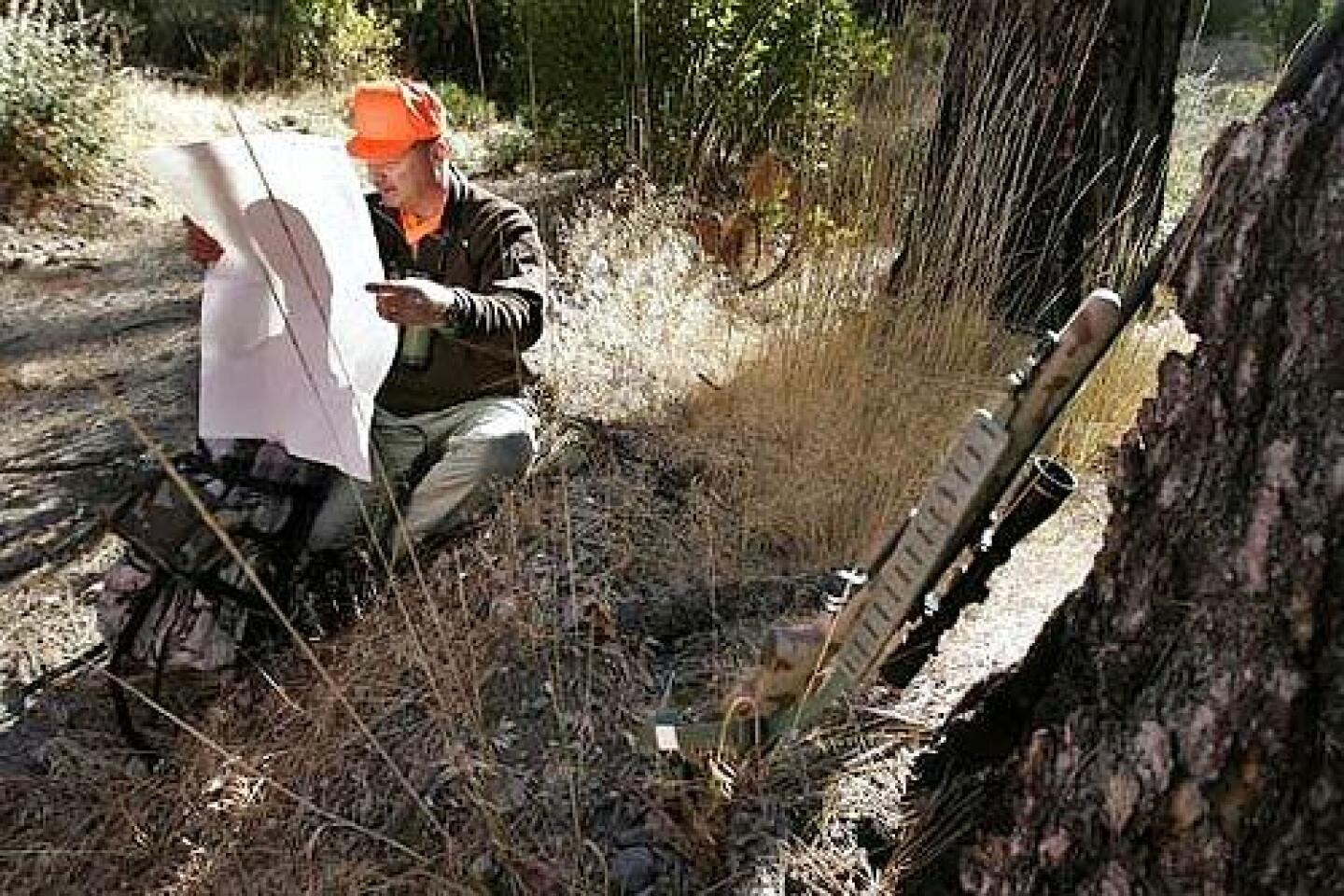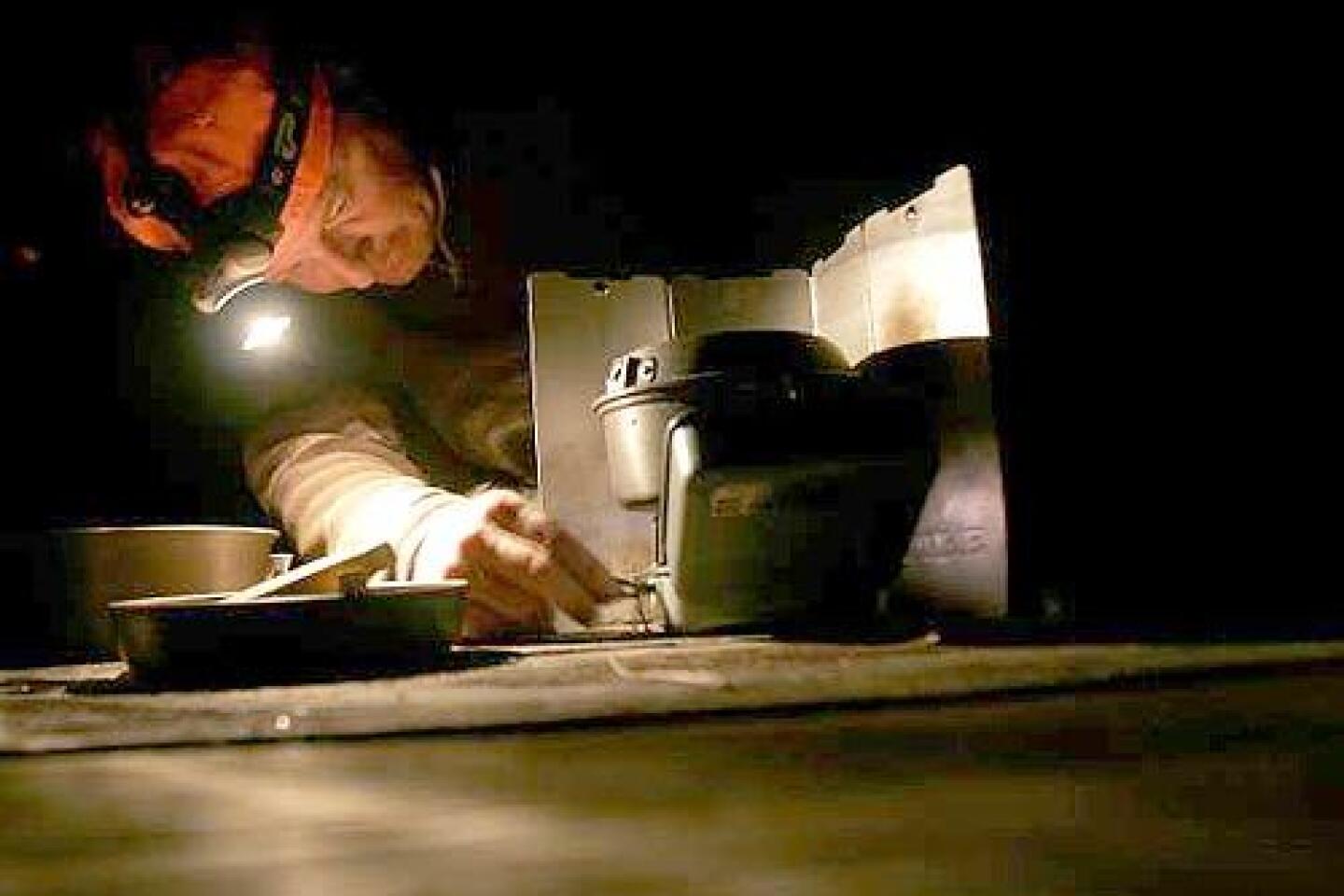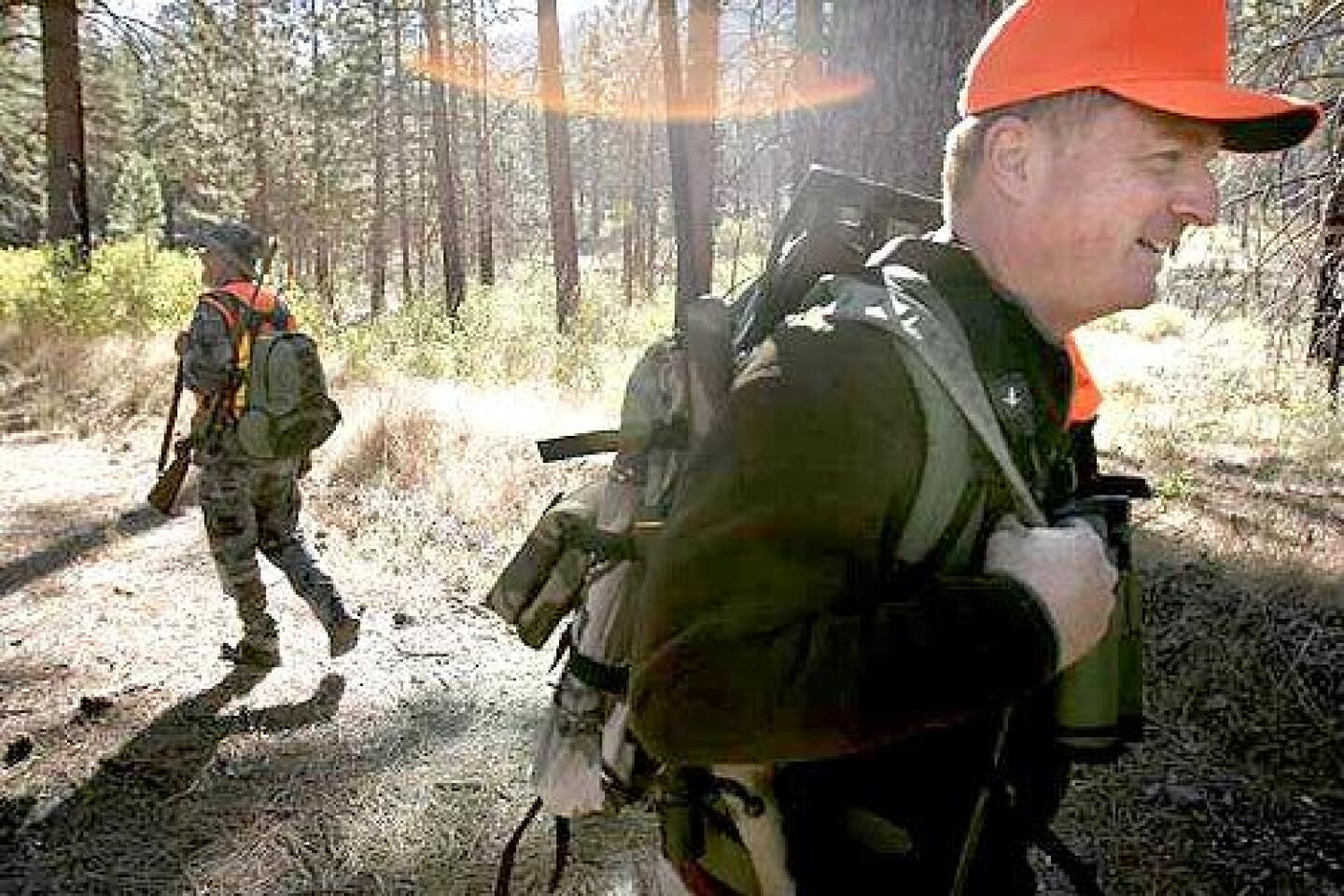Hunting in a forbidding zone
The day before the deer season opener earlier this month, Arl Farris is scaling a 45-degree slope heading up a 6,250-foot high ridge in the San Gabriel Mountains. Ahead is a gantlet of disintegrating granite, overhead chaparral and thorn bushes that snap his face as he presses through. Behind is a valley of pines and broken cliffs and fog as lovely as an Ansel Adams photo.
Footing is very unstable, but Farris, a longtime hunter and former San Marino police chief, knows this shaky terrain. He moves up the ridge in seamless methodical motion, relying on momentum to keep him from falling backward onto boulders and yucca. From the top, near Mt. Baldy, the 45-year-old hunter can see vast distances and scout for deer he hopes to shoot the next day. It’s a needle-in-a-haystack proposition because Farris is in the middle of the worst deer-hunting country in California.
This is hunting zone D-11, wedged up against the Los Angeles basin, prone to drought and fire, comprised of some of the steepest, most impenetrable, most crumbly slopes in North America. Over the last 15 years, hunters report that fewer than 4% who come here actually bag a buck — worse odds than even in the harsh Mojave Desert, according to the state Department of Fish and Game.
Yet every year thousands of hunters hope to beat the odds. Farris is among them. He has hunted these mountains since his father brought him here when he was a boy, and last season, he too brought his son. In more than 30 years of hunting, in California and other Western states, Farris has killed about 40 deer — but only four in D-11. That’s substantially better odds than the average hunter in these parts, and he prizes deer he takes here more than any trophy hanging on his wall.
“It’s exhilarating and exhausting to be in an area where you’re pursuing animals that have never seen people before, yet you’re within 30 miles of downtown Los Angeles,” Farris says. “You could put this place, D-11, against any place in the country for steepness, for roughness, for inaccessibility, and this would be among the worst. That’s where these deer are everyday. It really makes you appreciate the animals.”
Many hunters come to the Angeles National Forest, where the D-11 zone is, because it’s close to home and they can hunt for a weekend or a morning for little cost. Just clear the front ridge of the mountains, and traffic gridlock fades. It’s a bit of wilderness solace from the urban fray. For many, getting a deer is secondary; overcoming the punishing terrain, a kind of wily prey of its own, is the real challenge.
An estimated 2,200 mule deer inhabit the vast D-11 zone in the San Gabriel Mountains, said Fish and Game department wildlife biologist Rebecca Barboza. The terrain is so brushy, steep and wild no one can make an accurate count. There are more hunters in this field than deer; 3,655 people bought deer tags this season.
Like Chicago Cubs fans, longtime D-11 hunters nurture a stoic loyalty hardened by years of disappointment. Each season they fail to bag a deer fuels their determination to succeed the next.
It takes a special drive to pursue game here, says Dan Reyna, 55, of Placentia. “It’s slim pickings. You have to work hard and be that lucky guy.”
Hours of sitting
FARRIS is the sort of fellow who makes his own luck. Two years ago he chartered a helicopter to scout the mountains before opening day. That’s when he discovered prime habitat in a canyon south of Wrightwood. The steep slopes funnel into a wide, sunny meadow tangled with coffeeberry bushes covered in berries — a deer delicacy. Animals leave the trees and dense brush bordering the meadow to feed. To get a shot at one, Farris knows he must get in position early in the day and seize the high ground. And hope that few other hunters are there to upset the quiet.Although deer hunting may sound violent and aggressive and action-charged, it’s mostly sitting motionless on a rock or log for hours in cold weather high in the mountains. Tedium and shivering are punctuated by gunfire and adrenaline.
By the time Farris approaches the top of the ridge, his flesh is scratched and poked by nettles and yucca spines that pierce his clothes. He hunkers down on his haunches and creeps slowly over the top and down into the meadow. His every motion is measured and steady, no jerky actions that might spook animals or betray his position. For hours until sunset, he sits utterly still, using his Swarovski binoculars and spotting scope to scan for deer. “Glassing,” as it’s called, offers the boredom of fishing without the boat or the beer, yet it’s monotony with a purpose.
This is stealthy ambush work, and hunters try to spot animals before they spot them. As for the impatient yahoo who zooms in for a day in a big four-wheel-drive truck and lingers near the roads? Forget it. Those casual hunters, experts say, are part of the reason for D-11’s low success rate.
“Only a very few people will get off the highway and into this wild place where the animals are,” Farris said. “That’s part of the beauty and the curse of the San Gabriel Mountains.”
Hours pass as he holds his position. Farris munches a carrot. Two ravens spiral overhead. A hushed wind washes through the canyon. Toes grow numb as the sun dips low on the horizon and gilds the meadow. Still no deer. Farris decides to launch his hunt on the opposite ridge — a high, bare backbone with promontories that peer out over the canyons — in the morning. Heading back to camp, he finds deer droppings amid waist-high yellow and purple wildflowers. It’s a good sign.
Deer base camp is an unexpected commotion and crowd and agitation that Farris was not anticipating. The camp has been closed during deer season for as long as he can recall, but inexplicably, the gate blocking the road was opened, and about 50 hunters have converged on what had been his secret, nearly private, spot.
There’s a group of about 15 men with a barbecue in one party, a couple of twentysomething men hunting with their dad and a guy with a rifle rack affixed to his mountain bike. It looks like any other camp: lanterns, trucks and trailers, and propane stoves, although interspersed with rifles and big knives.
Deer camp is part male bonding and part poker game. The men are affable, and camaraderie grows with each story swapped. Some tell extraordinary tales of hunting success in these mountains beyond anything D-11 veterans know to be true. Bravado is as old as hunter-gatherers themselves. Men examine one another’s gear and size up each other’s prowess. Farris is friendly, but cagey, advising new hunters about promising places to find deer, but not revealing his best spots. Mostly, he wishes all these guys were not here.
He dons a headlamp and soon his cooking pots bubble with chili, mashed potatoes and hot chocolate to ward off the 40-degree night chill. Amid cold air and anticipation the night before opening day, sleep comes slowly after dinner. Moments later, it seems, the alarm sounds: 3:30 a.m. Time to climb mountains again.
After a quick breakfast, Farris tries to work out a crick in his back as he heads toward the trail, hoping to reach by sunrise the high ridge he saw the previous day — and do so before other hunters find it. Stars glint cold and bright above the dark treetops. Orion is gleaming.
But not many steps along the path, a cluster of bobbing flashlights illuminates the switchbacks ahead. Soon, several groups of hunters, clad in camouflage and orange, march on his heels. They are heading to the high ridge as well.
Farris knows that too many people hunting the same spot make too much noise. It can also be dangerous once shooting begins, so he changes plans and heads back to the canyon filled with coffeeberry bushes, where he glassed the meadow the night before. He figures his hunting technique, part stealth and lots of patience, will work better if he gets away from the crowd. It will prove to be a fateful decision.
He picks up the route in the dark forest and ascends a ledge, moving less steadily now than in the daylight. A flashlight casts a dim ring of light in the bramble, but doesn’t illuminate the sharp, wobbly rocks that trip hiking boots. It takes 30 minutes to climb a few hundred feet.
Stars wink out one by one as milky blue daylight floods over the mountains at dawn. The forest wakes up with flutters of birdsong and movement. First light is prime time for hunting as deer exit heavy cover to feed or move.
Here, and then gone
FARRIS has barely settled into his stand when, as if on cue, two deer stroll into the meadow. In a single, slow-motion movement, Farris’ body grows tense and sharpens as he lifts his 30-06 rifle to his shoulder and gently, quietly, slides the bolt and loads a cartridge into the chamber. Holding the weapon with his left hand, he peers through binoculars in his right to see if the animals have antlers (hunters can only kill bucks in D-11). But deer are phantoms, and they seemingly vanish into the brush from which they came. It’s the last he will see of them. He is vexed and thrilled.“Just to see deer in D-11 really makes it a very, very successful trip,” he says.
Minutes after the two deer elude Farris, shots come crashing over the mountain. A volley of gunfire follows. The deer, ignoring the succulent forage of the meadow, appear to be holding on the high ridge. Same high ground Farris intended to go for opening day. Same high ground where, it seems, most every other hunter in these parts went. More gunfire erupts from the high ridge.
By mid-morning, shooting subsides. Farris has not seen any deer since daybreak. Stiff and cold, he gathers his gear, stuffs it into his pack and heads down into the valley. So do half a dozen other hunting parties, marching through brush like fluorescent-orange ants. Some hunters bark into walkie-talkies; others holler across the valley.
Farris tramps off the road, seeking solitude in nearby brushy fields. He finds fresh scat, trodden brush and deer hoof prints, but no deer. He climbs another ridge, and starts the process all over, patiently staring at hillsides with his binoculars and spotting scope. He sees nothing.
Accepting futility, he heads back to the base camp, dejected.
In camp, the other hunters return with five bucks, most shot through the heart up on the high ridge. One man drags in a three-pointer — a rare trophy in the San Gabriel Mountains where anything bigger than a forked-horn, or a two-point deer, is cause for celebration. Another hunter arrives with a backpack of meat.
Yet still D-11 has lived up to its reputation. Most hunters fail to get a deer. Even experienced woodsmen like Farris are humbled. The habitat in these mountains may be poor, but the deer are well adapted and elusive. Frustration goes with the territory.
While it is the worst place to hunt in California, there is a bond, a collegiality forged among strangers who come here from all over Southern California, joined in a single moment for one common purpose. They have taken deer within view of skyscrapers in downtown Los Angeles, watched bobcats take down does, seen bighorn sheep bound up cliffs. It is a wild place close at hand.
Farris plans to return again before the hunting season ends on Nov. 6. He will hunt again, hoping to get a deer. If he’s lucky.
Deborah Sullivan Brennan can be reached at outdoors@latimes.com.
Sign up for The Wild
We’ll help you find the best places to hike, bike and run, as well as the perfect silent spots for meditation and yoga.
You may occasionally receive promotional content from the Los Angeles Times.
